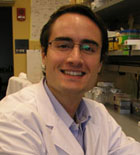Contact Information:
Research Staff

Ann V. Hertzel, PhD
Research Assistant Professor
I am a native Minnesotan and attended Mankato State University (Mankato, MN), receiving a B.S. degree in Biochemistry in 1987. After working a year as a technician, I entered the Biochemistry graduate program at the University of Minnesota and obtained a Ph.D in 1994. I have two children, ages 3 and 1. I enjoy the outdoors and am a cycling enthusiast. I also enjoy hiking, camping, reading and I spend considerable time with birders
Fatty acid binding proteins (FABP) provide intracellular solubilization and trafficking of fatty acids. This intracellular function results in changes in overall energy storage and utilization. The adipocyte FABPs (A-FABP and E-FABP) play a role in overall body glucose/insulin homeostasis. Knockout mice for the adipocyte FABP (A-FABP) have increased insulin sensitivity whereas the epithelial FABP (E-FABP) over expressing transgenic mice have reduced insulin sensitivity as assessed by fasting glucose, fasting insulin, glucose and insulin tolerance tests. We are currently utilizing these animal models to decipher the role of adipocyte FABPs in lipid and glucose homeostasis.

Wendy Hahn, BS
Scientist
I was born and raised in Minnesota. After receiving a BS in Microbiology from the University of Michigan, I worked for several years at the University of Michigan Medical School in the Physiology Department. It was there that I received my initial training into mouse models and the intriguing world of adipocyte biology. I returned to Minnesota and joined the Bernlohr lab in July of 2005. I currently reside in Hastings with my husband Justin and our dog Kota.
hile I enjoy the title of lab safety officer and mouse colony manager for the Bernlohr lab, I’m also part of an exciting research team focused on metabolic consequence of accumulation of reactive aldehyde 4-HNE. Oxidative stress results in formation of several species of reactive aldehydes via lipid peroxidation which can modify proteins and alter function. One of these reactive aldehydes, 4-HNE, can be conjugated to glutathione and exported by Glutathione S Transferase A4. The selective down regulation of GSTA4 in adipose tissue in obese insulin resistant mice and humans was recently discovered in our lab. GSTA4 Knock-down or null mouse models reveal several interesting metabolic phenotypes including mitochondrial dysfunction. I am currently developing cell lines and a transgenic mouse that express GSTA4 from an adipocytes-specific promoter to rescue the expression of GSTA4 in obese mice. These models will enable us to discern the contribution of GSTA4 and 4-HNE levels to insulin resistance and mitochondrial dysfunction associated with obesity.

Kristina Hellberg
Graduate Research Assistant
I was born in Karlskoga, a small town in the middle of Sweden. I graduated with a master of science from Linkoping University, Sweden, in 2007 in chemical biology with biomolecular techniques as my branch of studies. In the fall of 2006 I came to the University of Minnesota as an exchange sudent for a semester. I liked he university and Minnesota so I joined the BMBB graduate program in 2007. My hobbies include traveling, working out and reading.
atty acid binding proteins (FABP) are proteins that help solubilize and transport fatty acids in cells. The adipocyte isoform of FABP (AFABP) is mainly expressed in adipocytes and macrophages and, interestingly, AFABP knock out mice are more insulin sensitive and protected from atherogenesis compared to wild type mice. AFABP can interact with other proteins such as hormone sensitive lipase (HSL), janus kinase 2(JAK2) and the nuclear recepor peroxixome proliferator-activated recepor y, (PPAPy). My research project is to further characterize how AFABP can interact with other proteins.
Marissa Lee
Undergraduate Associate
I am an undergraduate student here at the University of Minnesota. I am a sophomore and am thinking about a major in the arts. I am interested in all different kinds of art, from painting to drawing to sculpture. Besides art, I love to be outdoors, especially in the summer, and enjoy hiking, rock climbing, and going to my family’s cabin. I am currently living off-campus with my boyfriend and our hamster, Doris. We also like spending time with friends and family and going to see movies.
Although I am not a student of biology, I really enjoy working in the lab. I am basically a lab attendant, washing bottles for cell culture, keeping important tools and solutions stocked, and cleaning and organizing the lab. I also help the researchers with cell culture on the weekends, which I have found to be very interesting. I try to keep the lab running as smoothly as possible to allow the people who do research to do so easily and efficiently.

Federico J Serrot, MD
I was born and raised in Argentina (home of the best steak and barbecues in the world). I finished medical school in Buenos Aires in 2007. During the following year I took the medical board exams and stayed as an observer at the Department of Surgery for 3 months. I am planning to do my residency in Surgery as soon as I finish my two years of research fellowship. Apart from working, I enjoy outdoor sports, specially soccer and tennis (now only during summer). I will enjoy cold (really cold) winters learning how to ski. Wish me luck!
am working as a research fellow at the Department of Surgery with Dr. Sayeed Ikramuddin (Bariatric Surgeon). My research project is focused on the effect of weight loss surgery on type 2 diabetes mellitus. We are looking at adipocyte changes regarding oxidative stress and mitochondrial function before and after the surgical intervention in both human and animal models. We would also like to study the effects of incretins on adipose tissue and insulin resistance. This will hopefully help to better understand the improvement of diabetes mellitus after bariatric surgery.